How Midsommar celebrates the sun and keeps Swedish traditions alive
Every June, the town of New Sweden, Maine hosts a three-day Midsommar Festival. In Swedish tradition, the Midsommar holiday is as important as Christmas

A girl wears a hair wreath of flowers as she's surrounded by blooms.
(New Sweden Historical Society)
Summer in Maine is a sight to behold, as the land comes alive with sun-kissed bursts and blooms of flowers.
In the town of New Sweden, Maine, the start of the new season is commemorated with the Scandinavian holiday known as Midsommar, along with a three-day Midsommar Festival they host every June.
The Midsommar Festival celebrates the summer sun and helps Swedish-Americans in the community keep their traditions alive.
Here comes the sun
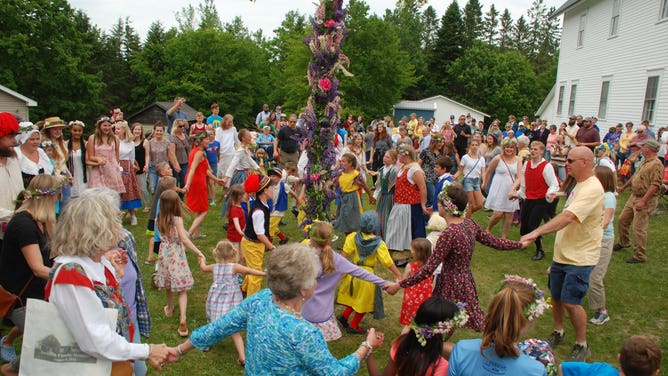
Festival-goers dance around the centerpiece of Midsommar Festival, the Midsommar Pole.
(New Sweden Historical Society)
"I think if you step into the festival, you get this feeling of immense joy and happiness because winter's over at last," said Brenda Nasberg Jepson, documentary filmmaker and co-chair of the New Sweden Historical Society's Midsommar Festival Committee in New Sweden, Maine.
"To celebrate with everybody is just great because we've all been in our little houses all winter trying to keep warm by the wood stove. And now, at last, the sun is out, we can all come out and celebrate together."
Midsommar occurs around summer solstice. The longest day of the year, summer solstice usually falls near June 21 and cues the beginning of summer in the astronomical calendar.
LEARN ABOUT THE SCIENCE BEHIND THE SUMMER SOLSTICE
"And that's what we're celebrating is the sun and then the coming of the summer," Jepson said.
"At the same time, it's the most perfect time of year for gorgeous, gorgeous flowers, wildflowers, lupines and purple veg and daisies," she added. "We're collecting all these and celebrating the sun and the flowers."
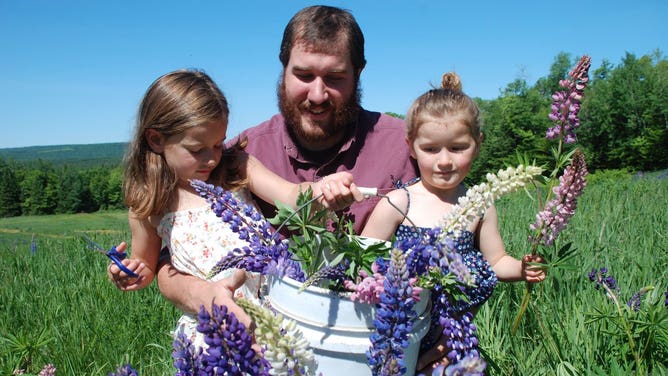
Robert Barnett and his daughters gather flowers for Midsommar in New Sweden, Maine.
(New Sweden Historical Society)
This seasonal shift is significant for the community of New Sweden. Given its location in the northernmost region of Maine, Jepson noted how the town experiences winters that are "brutally cold" — not unlike the winters experienced in the ancestral lands of the town’s predominantly Swedish-American residents.
In addition to celebrating the warm days of summer, the Midsommar Festival is also an opportunity for the people of New Sweden to share the traditions involved in the Swedish holiday.
"It's just fun seeing everybody come and having fun and learning about Swedish culture and enjoying it," Jepson said.
According to Jepson, in the Swedish calendar, Midsommar is as important as Christmas.
How Midsommar came to Maine
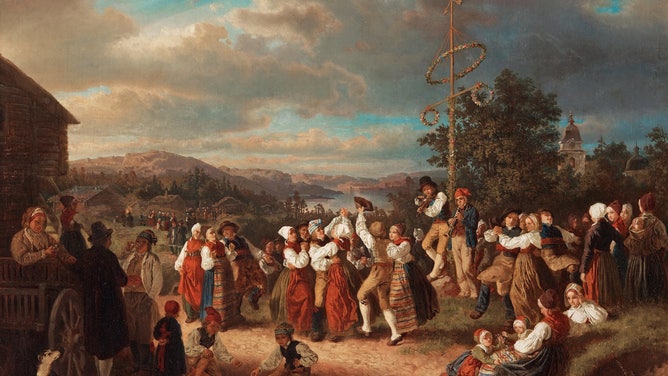
Midsommar dance in the municipality of Rättvik in Sweden.
(Fine Art Images / Heritage Images / Getty Images)
The story of Midsommar in New Sweden begins in the old country, hundreds of years ago.
The holiday was originally a pagan festival celebrated in Sweden and other Scandinavian countries. According to Encyclopedia Britannica, Midsommar was "likely related to ancient fertility practices and ceremonies performed to ensure a successful harvest".
When Christianity arrived in the region, Midsommar had to adopt a new meaning and one within the context of the new religion. It was then attached to the birthdate of John the Baptist.
THE PAGAN AND CHRISTIAN ORIGINS OF HALLOWEEN
In 1870, the holiday was brought to New Sweden, Maine, by way of Swedish immigrants. Their arrival to the U.S. was part of an effort to revive the Pine Tree State's population and farms at the time.
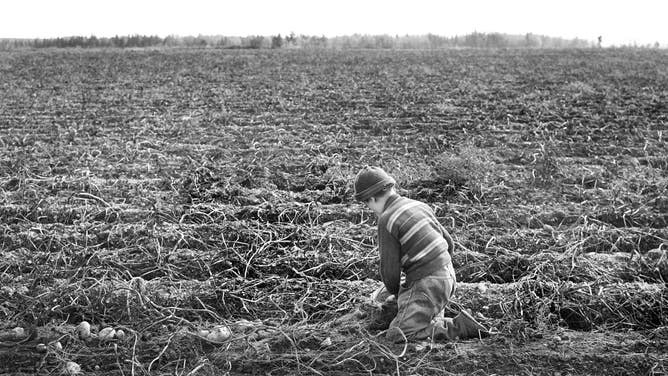
A boy picks potatoes on a farm in Maine.
(Universal History Archive / Getty Images)
According to Jepson, the sons of Maine’s farmers had left the state to fight in the Civil War. After the war ended, many of the men decided to venture to the fertile lands of the western U.S. rather than return to till the rough terrain of their homestate.
"The state panicked because the land would be left abandoned," Jepson said. "So, they asked William Widgerey Thomas, who had been ambassador to Sweden under Abraham Lincoln, to go to Sweden and round up all these Swedish people who would come here and wouldn't mind the cold weather or the rocky soil."
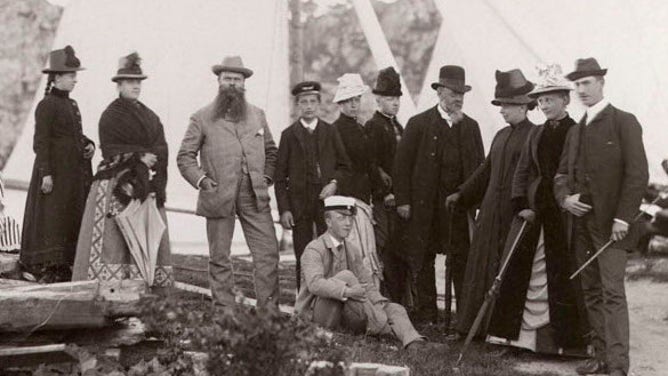
Maine politician and American ambassador to Sweden William W. Thomas Jr. (bearded man) stands with a family in Sweden.
(Swedish National Heritage Board)
The ambassador’s efforts brought about 51 settlers to New Sweden, Maine. Today, many of the town’s residents can trace some of their ancestries to these original settlers.
According to Jepson, life was difficult for the early Swedish immigrants, as they struggled to plant their crops, prepare for their first winter and survive a bout of flu. However, they found ways to keep their traditions, such as Midsommar, alive in their new home.
"I think it would it was wonderful for them because it helped them to connect them to back to the old country," Jepson said. "I'm sure that they marked the day as they would have Christmas because, I know it must sound strange, but Midsommar is as important in the Swedish calendar as Christmas."
Glad Midsommar!
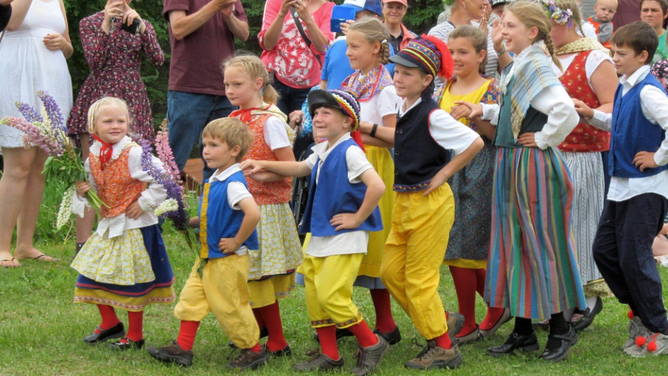
Children in traditional dress dance during Midsommar Festival 2018.
(New Sweden Historical Society)
Today, the descendants of the original Swedish immigrants carry on the traditions of their forebears and share them with others during Midsommar Festival in New Sweden.
"We get visitors who don't even have relatives here. They've just heard about this little pocket of Swedish culture in northern Maine where things are still very traditional and they're fascinated to come and see it," Jepson said.
According to Jepson, some activities include learning how to sing in Swedish, eating Swedish meatballs and other ethnic Swedish cuisines, playing Kubb and other Swedish games, painting wooden toy horses called Dala horses, wearing traditional period dress and performing old dances.
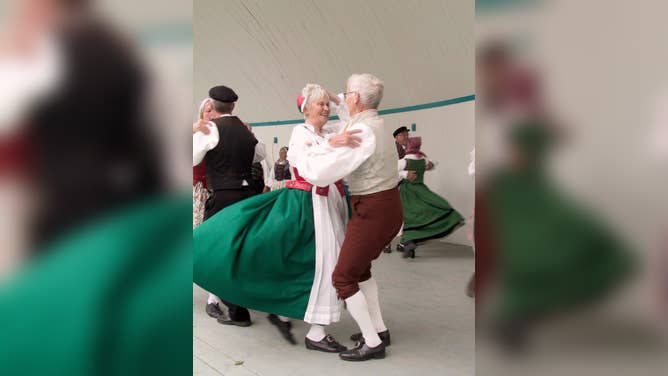
A couple performs a traditional dance.
(New Sweden Historical Society)
"We have one big, long dance we do called The Long Dance, and we all hold hands and we go round and round and round," Jepson said. "The group comes together in a tight, tight coil, and then at the very end, we all throw our hands up and we say, ‘Glad Midsummar!’ which means ‘Happy Midsommar!’."
HOW ANOTHER POPULAR HOLIDAY CELEBRATES THE CHANGING SEASONS
Prominently on display are the flowers of summer. Midsommar Festival-goers can even don these blooms by learning how to make hair wreaths out of them.
The star of the show is also adorned in flowers.
"In the same way that the Christmas tree is the emblem of Christmas, at Midsommar, the emblem or the main feature of it is the Midsommar Pole," Jepson said.
The basis of the pole is made out of tamarack and birch. Then, members of the community gather buckets’ worth of lupines and other flowers, which they use to decorate the Midsommar pole. It is then marched into the festival venue with music playing in the background. Once set up, children come out and dance around it.
"When you look at the Midsommar pole, you're not just looking at a thing of beauty, you're thinking about all the people that took together all those flowers and the community effort," Jepson said.
"It's emblematic of great joy and community spirit and the summer and the beauty of flowers — it's everything, all those things."
Living history
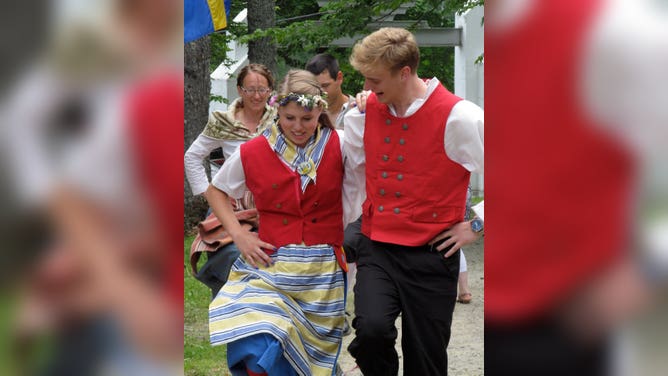
Young men and women dance in traditional Swedish dress.
(New Sweden Historical Society)
As it was celebrated by the first Swedish immigrants in New Sweden, Midsommar has a special meaning for those celebrating the holiday today in Maine.
"It's a way to have a living history — you're not just reading about it, you're doing it," Jepson said. To Jepson, festival-goers feel as if they're walking back in time or walking back into history and experiencing Midsommar as the early Swedish immigrants would have.
LEARN ABOUT THE SCANDIVANIAN ORIGINS OF YULE LOGS
"I think it's really neat that in America we're a cultural melting pot. We have all these different cultures, and it's just fun to learn about how other people live, how they celebrate a little bit about their history — and when people come here for Midsommar, everybody is a Swede."


